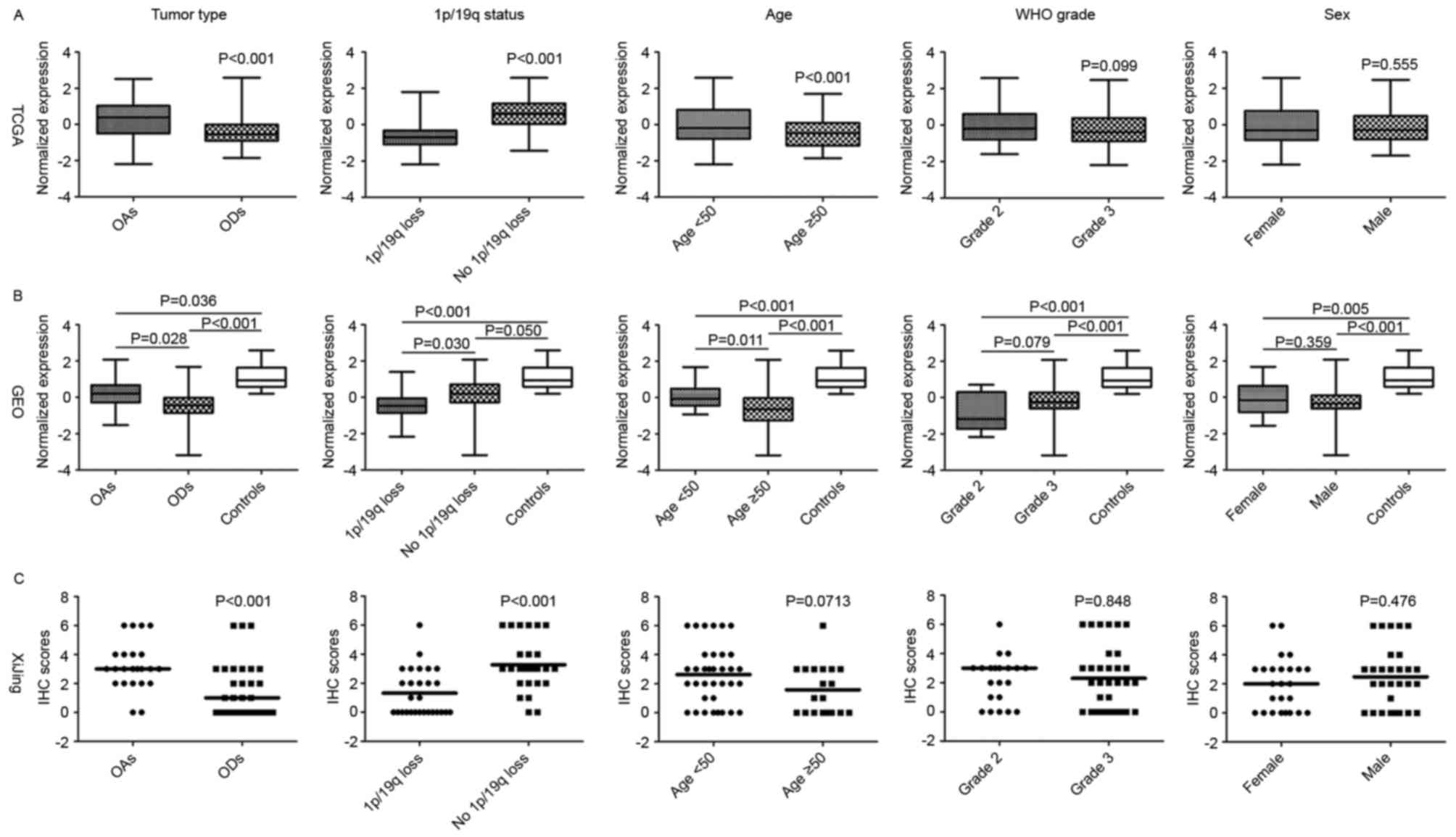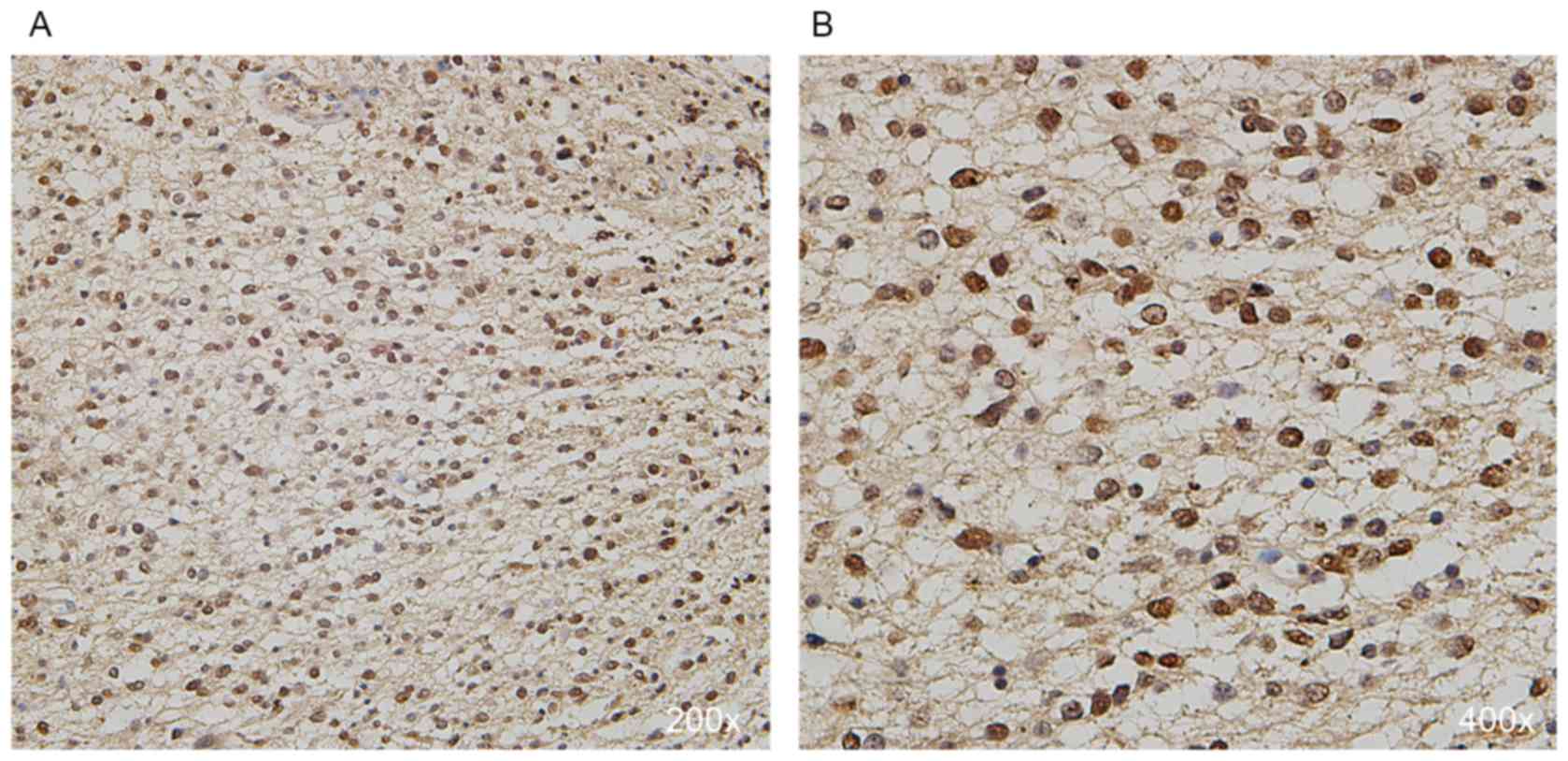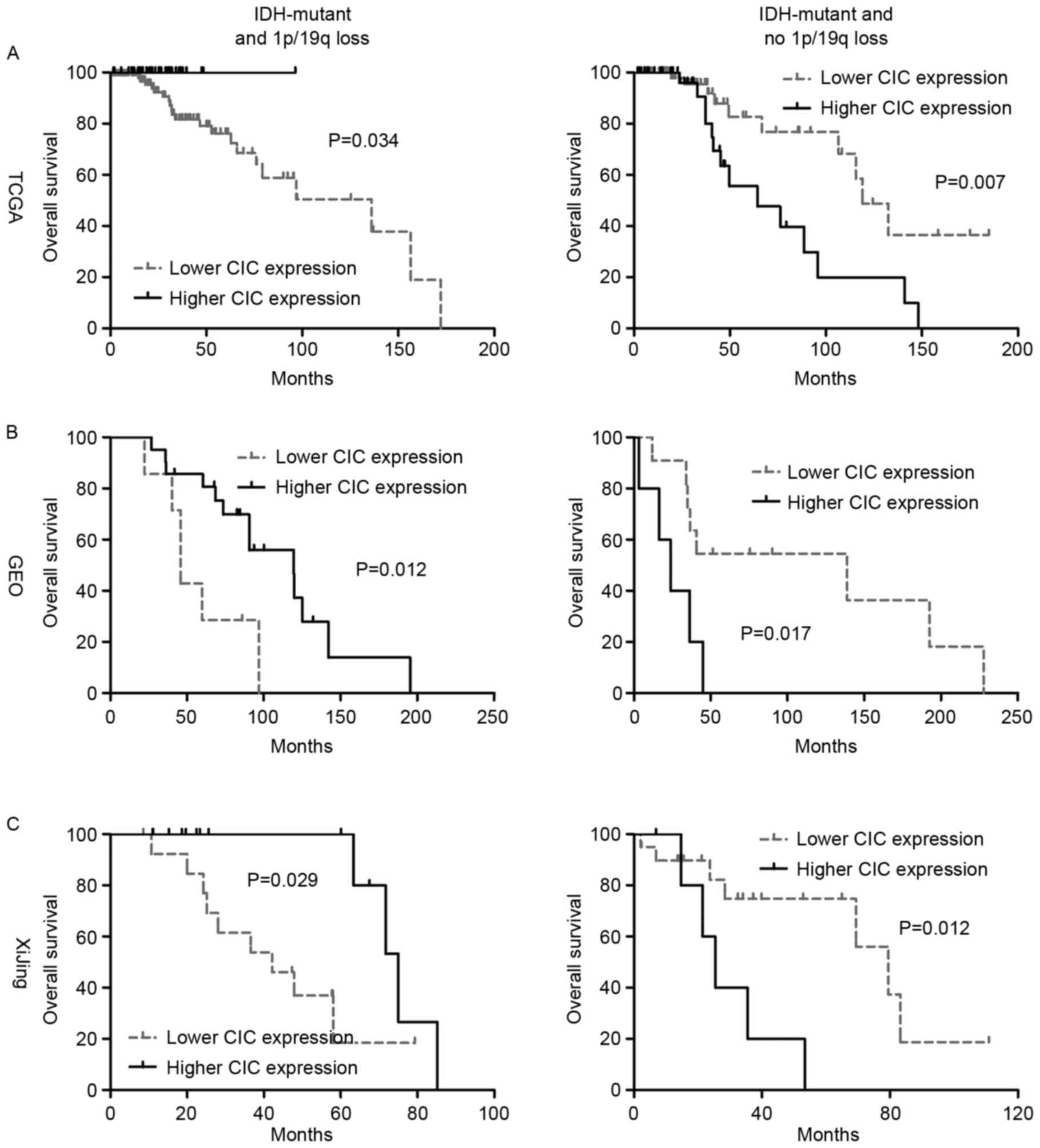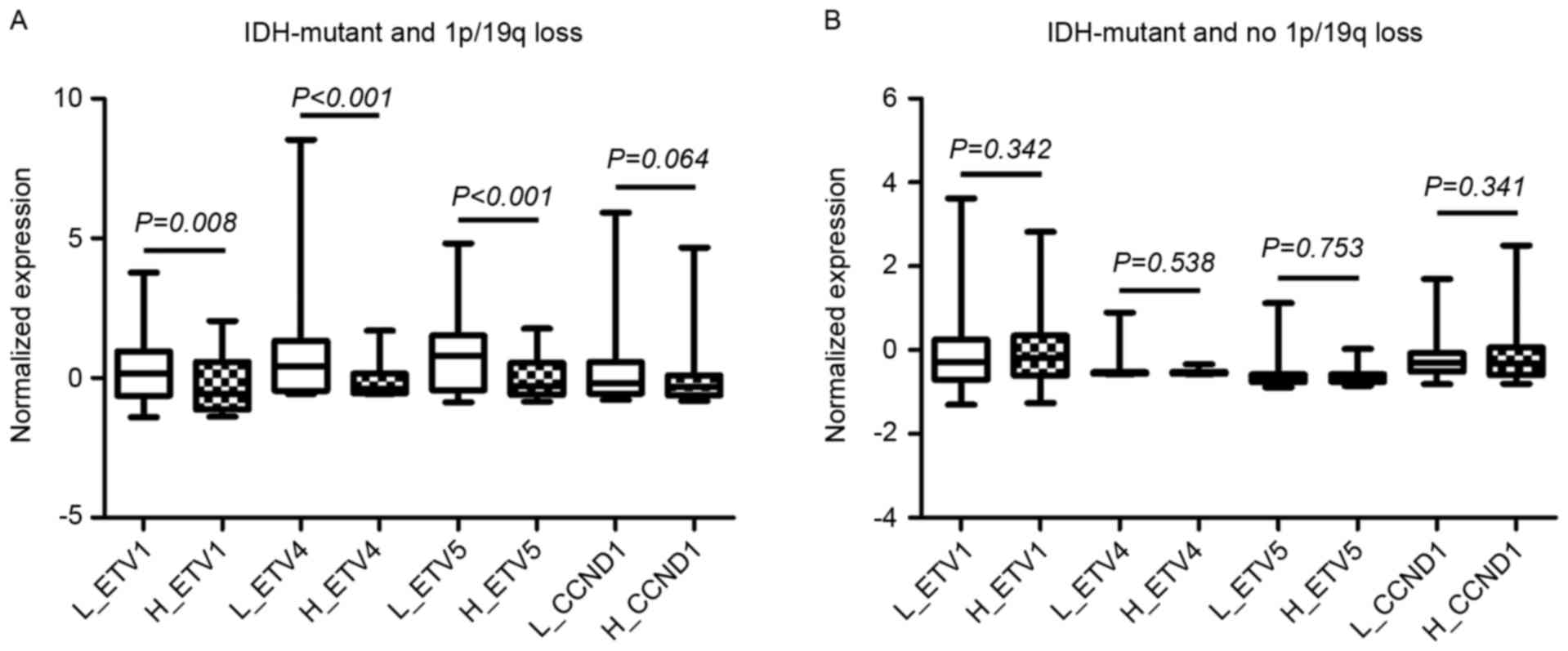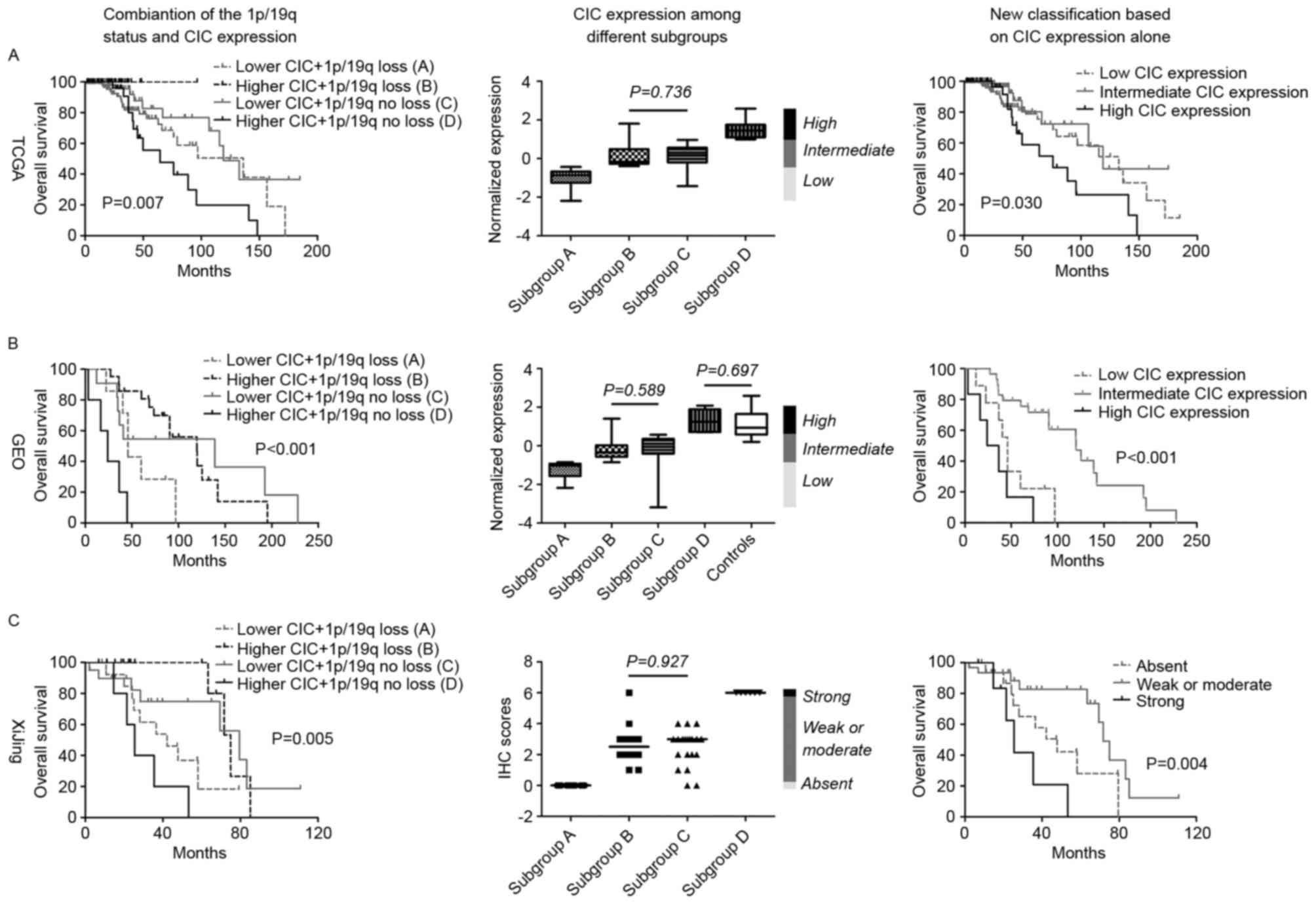Altered capicua transcriptional repressor gene expression exhibits distinct prognostic value for isocitrate dehydrogenase-mutant oligodendroglial tumors
- Authors:
- Published online on: November 21, 2017 https://doi.org/10.3892/ol.2017.7460
- Pages: 1459-1468
-
Copyright: © Han et al. This is an open access article distributed under the terms of Creative Commons Attribution License.
Abstract
Introduction
Oligodendroglial tumors, including oligodendrogliomas (ODs) and oligoastrocytomas (OAs), present as distinct histopathological and clinical subsets of glioma, with slow growth and a favorable prognosis (1,2). Oligodendroglial tumors account for <10% of the diffuse gliomas (2). The histopathological diagnosis of these tumors is difficult: OAs with typical morphological features are histologically well defined, whereas other non-classical tumors, OAs in particular, are more challenging to diagnose due to equivocal definitions as a result of sharing oligodendroglial and astrocytic morphology, as well as the uncertainty of representative tumor sampling (2,3). Therefore, histological diagnosis provides inadequate prognostic information on oligodendroglial tumors, as demonstrated by markedly varied survival times among patients with similar histological features in the clinic (2).
Like other tumors, oligodendroglial tumors develop as a result of heterogeneous genetic and molecular alterations (1). These tumor-specific molecular abnormalities determine the clinical and biological behavior of each tumor; therefore certain molecular biomarkers may provide useful clinical information (2). At present, two identified biomarkers for oligodendroglial tumors are mutations in isocitrate dehydrogenase (IDH)1 and IDH2 (referred to collectively as IDH), and the loss of heterozygosity of chromosome arms 1p and 19q (2). IDH mutations are observed in 70–80% of oligodendroglial tumors and are associated with an improved survival time (2). The complete co-deletion of 1p/19q resulting from an unbalanced translocation is present in 60–80% of ODs, whereas it is observed less frequency in OAs (10–15%) (4); this genetic alteration is associated with a positive outcome and response to chemotherapy (5). The majority of 1p/19q co-deleted oligodendroglial tumors also exhibit IDH mutations (6).
Sequencing studies have identified recurrent mutations in the Capicua transcriptional repressor (CIC) gene within 50–70% (2) of 1p/19q co-deleted oligodendroglial tumors (1,3,4,7–10). CIC is situated on cytoband 19q13.2 and encodes a 164 kDa protein containing a high-mobility group box (9). The gene was first identified as a downstream repressor of the receptor tyrosine kinase signaling pathway in regulating developmental patterning and cell fate in Drosophila (11). Mutations in this gene are almost exclusively observed in oligodendroglial tumors (3,7). Certain mutations may result in CIC repression; tumors with this mutation comprise an aggressive subset of 1q/19q co-deleted gliomas (4). However, there are inconsistent reports regarding the association between CIC mutations and prognosis in patients with oligodendroglial tumors; some reported a significant survival correlation of CIC mutations whiles others did not (4,8,9). Therefore, the aim of the present study was to investigate the prognostic ability of altered CIC expression level as an alternative to CIC mutation status among IDH-mutant oligodendroglial tumors with or without co-deletion of 1p/19q.
Patients and methods
Patients and samples
Data and samples from patients with glioma who were admitted between January 2003 and December 2012 to the Department of Neurosurgery, Xijing hospital (Xi'an, China) were reviewed in the present study. A total of 54 patients who met the following inclusion criteria were included in the present study: i) Aged >18 years; ii) with pathologically confirmed oligodendroglial tumors, including ODs and OAs [World Health Organization (WHO) grade II to III]; iii) carrying IDH1 mutations (as determined by anti-IDH1R132H immunohistochemistry (IHC) analysis at the Department of Pathology, Xijing hospital); iv) with available records of 1p/19q status (determined by fluorescence in situ hybridization analysis at the Department of Pathology, Xijing hospital); and v) with written informed consent. The histopathologic features and WHO grading were evaluated according to the WHO 2007 classification (12). Formalin-fixed, paraffin-embedded tumor tissues were examined in the present study. All patients underwent the radical neurosurgery of primary tumors and received stereotactic fractionated radiosurgery, with a median total dose of 36 Gy, postoperatively. Patient demographics and clinical data were retrieved from the Xijing Hospital electronic medical record system. Local institutional review board approval was obtained to use archived material for study purposes. All procedures performed with human tissue were in accordance with the ethical standards of the institutional research committee and with the 1964 Helsinki declaration and its later amendments, or comparable ethical standards.
IHC staining for CIC protein
The protein expression of CIC was examined by IHC staining. In the literature, the vast majority of mutations in CIC occurred in exons 5 and 20 (3,9). Therefore, an antibody specific for the C-terminus region of CIC protein (cat. no. TA590520; OriGene Technologies, Inc., Rockville, MD, USA) was used. IHC staining was performed as described previously (13); briefly, paraffin-embedded sections were deparaffinized and rehydrated, and antigen retrieval was performed. Subsequently the tumor sections were immersed in methanol containing 3.0% hydrogen peroxide for 20 min to block endogenous peroxidase activity, and incubated in 2.5% goat serum (Abcam, Cambridge, UK) to decrease non-specific binding. Thereafter, tumor sections were incubated at 4°C overnight with the primary anti-human CIC antibody (dilution, 1:1,000) followed by incubation with a horseradish peroxidase-conjugated goat anti-rabbit IgG antibody (dilution, 1:1,200; cat. no. A32732; Pierce; Thermo Fisher Scientific, Inc., Waltham, MA, USA) for 30 min. Immunolabeled sections were visualized by staining with 3,3′-diaminobenzidine (Sigma-Aldrich; Merck KGaA, Darmstadt, Germany) and counterstaining with hematoxylin. Negative controls were sections acquired from the same tumor without primary antibody incubation.
The CIC nuclear staining pattern was evaluated in a semiquantitative manner, as previously described (9). Briefly, the protein levels were scored by multiplying the degree of intensity by percentage of stained cells, with the intensity being graded as 0 (no staining), 1 (weak), 2 (moderate) and 3 (strong), and the percentage of stained cells being classified as 0 (<10%), 1 (10–50%) and 2 (>50%). The CIC scoring was performed by two independent investigators, with any scoring disputes resolved through discussion. Investigators were blinded to the clinical data of the assessed sections, but not to the objectives of the study. The scores were designated as absent (0), weak (1 and 2), moderate (3 and 4) or strong (6).
Public datasets of oligodendroglial tumors
The cancer genome atlas (TCGA)Clinical and demographical data from 265 patients (≥18 years old) with oligodendroglial tumors carrying IDH mutations were retrieved from the TCGA data portal (https://tcga-data.nci.nih.gov/). Somatic mutations in IDH and CIC were determined by level 2 Illumina Genome Analyzer DNA Sequencing data. For the assessment of the 1p/19q status, level 3 Affymetrix Genome-Wide Human SNP 6.0 array data were analyzed within the GISTIC2.0 module at GenePattern (http://genepattern.broadinstitute.org/gp). An amplitude threshold of ± 0.2 was used. Additionally, CIC mRNA expression levels were determined using level 3 IlluminaHiSeq_RNASeqV2 data.
Gene expression omnibus (GEO)Data from a total of 45 patients (≥18 years old) with oligodendroglial tumors carrying an IDH1 (R132) mutation or the glioma-CpG island methylator phenotype (G-CIMP) were obtained from the GEO data portal (http://www.ncbi.nlm.nih.gov/geo/) from the GSE16011 (n=30) (14) and GSE43388 (n=15) (15) datasets. The 1p/19q status was available for all samples. For each sample, CIC mRNA expression levels were determined using the log2-transformed RMA-normalized signal intensity from the Affymetrix Human Genome Plus 2.0 Microarray platform. In addition, expression profiles for 8 non-tumor brain tissues from the GSE16011 dataset were downloaded as controls.
Cross-dataset/platform mRNA data processingTo account for differences in systematic measurement between the distinct datasets and platforms, each set of CIC mRNA expression data was independently standardized by transforming the expression data to a mean of 0 and a standard deviation of 1, as per a previously described method (16).
Gene set enrichment analysis (GSEA)To assess the enrichment of gene sets within different subgroups, GSEA was performed with 1,000 permutations, as previously described (17). Gene sets derived from the Biological Process Ontology (Molecular Signatures Database; http://software.broadinstitute.org/gsea/msigdb) were evaluated.
Statistical analysisOverall survival (OS) time was defined as the time from diagnosis until mortality or the final follow-up. Survival data were analyzed using the Kaplan-Meier method and compared using the log-rank test. Univariate Cox regression analysis was performed to investigate the association between variables and OS time. A multiple Cox regression model was applied to investigate the independence of each prognostic indicator that was statistically significant within univariate Cox models. The associations between clinical and molecular variables were evaluated using a χ2 test or Fisher's exact test. Differences in CIC expression between groups were assessed by a Student's t-test or Mann-Whitney U-test. The optimal threshold to separate patients into the poor or good prognostic subgroups was determined by the maximally selected rank statistics (18). All calculations were performed with SPSS software (version 19.0; IBM Corporation, New York, NY, USA) and R software (version 3.2.5; https://www.r-project.org/). P<0.05 was considered to indicate a statistically significant difference.
Results
Expression pattern of CIC among IDH-mutant oligodendroglial tumors
The demographical and molecular characteristics of all included patients are presented in Table I.
By comparing CIC mRNA expression between tumor and non-tumor brain tissue from TGCA, it was identified that CIC mutations were associated with decreased CIC mRNA expression levels (unpaired t-test, P<0.001; data not shown), and were almost exclusively observed in tumors with 1p/19q co-deletion (Fisher's exact test, P<0.001; data not shown). Additionally, CIC mRNA expression was increased in patients aged <50 years compared with those ≥50, but no significant difference was observed between CIC mRNA expression and sex (Fig. 1A).
In the GEO samples, CIC expression was identified as significantly repressed in IDH-mutant oligodendroglial tumors relative to non-tumor tissue (unpaired t-test, P<0.05). Among tumors with distinct clinical or molecular features, OAs were associated with increased CIC mRNA expression compared with ODs, whereas no significant differences in CIC expression between grade II and III tumors were identified. Regarding 1p/19q status, CIC mRNA expression was significantly decreased in tumors with 1p/19q co-deletion compared with those without (Fig. 1B).
In the IHC examination of the tumor samples, it was observed that 16 (30%), 13 (24%), 18 (33%) and 7 (13%) cases were detected with absent, weak, moderate and strong nuclear expression of CIC, respectively (Fig. 2). All 4 cases with discrepancy were defined as weakly (n=3) or moderately (n=1) stained tumors after discussion (Three tumors were initially defined as moderately stained by one investigator but weakly stained by the other, while one tumor was initially defined as strongly stained by one investigator but moderately stained by the other). The protein expression patterns were consistent with the mRNA levels from the GEO and TGCA data (Fig. 1). Notably, absent CIC expression was significantly associated with 1p/19q co-deleted tumors (χ2 test, P<0.001) and ODs (χ2 test, P=0.006), whereas strong expression was associated with tumors without 1p/19q co-deletion (χ2 test, P=0.047; Fig. 1C).
Increased CIC expression is associated with a favorable prognosis in IDH-mutant, 1p/19q co-deleted oligodendroglial tumors
Of the 153 oligodendroglial tumors from TCGA with an IDH mutation and 1p/19q co-deletion, CIC mutations were detected in 100 (65.4%) cases. No significant association was identified between CIC mutations and OS time among TCGA samples (log-rank P=0.225). However, increased CIC expression was associated with a favorable prognosis in IDH-mutant oligodendroglial tumors with 1p/19q co-deletion (median OS time, higher vs. lower, not reached vs. 136.1 months; log-rank P=0.034; Fig. 3A). Similarly, among IDH-mutant and 1p/19q co-deleted oligodendroglial tumors from GEO, higher CIC expression was associated with longer OS time compared with lower CIC expression (median OS time, higher vs. lower, 119.5 vs. 45.7 months; log-rank P=0.012; Fig. 3B). Additionally, in the IHC examination of the present study cohort, patients with absent CIC expression exhibited a significantly shorter OS than those with detectable protein expression (weak, moderate or strong; median OS, absent vs. detectable, 75.0 vs. 42.2 months; log-rank P=0.029; Fig. 3C). These data collectively demonstrate that higher CIC expression is a favorable indicator for OS time among patients with oligodendroglial tumors with IDH mutation and 1p/19q co-deletion.
Higher CIC expression is associated with poor prognosis in IDH-mutant oligodendroglial tumors without the 1p/19q co-deletion
In contrast to IDH-mutant, 1p/19q co-deleted oligodendroglial tumors, only 4 cases (3.6%) were detected with CIC mutations in those without 1p/19q co-deletion from TCGA. In this subset of oligodendroglial tumors, higher CIC expression was associated with poorer OS (median OS, higher vs. lower, 64.4 vs. 119.0 months; log-rank P=0.007; Fig. 3A). The distinct prognostic ability was also confirmed in GEO samples (median OS, higher vs. lower, 23.8 vs. 138.8 months; log-rank P=0.017; Fig. 3B). Additionally, at the protein level, high nuclear CIC expression was also significantly associated with poorer OS (median OS, strong vs. lower or absent, 25.4 vs. 79.6 months; log-rank P=0.012; Fig. 3C). Therefore, the data collectively indicated that higher CIC expression is an unfavorable indicator for OS time among patients with oligodendroglial tumors with IDH mutations and no 1p/19q co-deletion.
Bioinformatics analysis
To explore the biological mechanisms for the observed distinct prognostic role of CIC expression level, the expression levels of previously identified genes targeted by CIC [ETS variant (ETV)1, ETV4, ETV5 and Cyclin D1] were compared within TCGA samples. It was demonstrated that among IDH-mutant, 1p/19q co-deleted oligodendroglial tumors, all the targets were significantly upregulated in the lower expression group compared with the higher expression groups (Fig. 4A), suggesting a decrease in the transcriptional repressor activity of CIC; whereas among the IDH-mutant, 1p/19q intact tumors, the expression of the target genes was not significantly altered (Fig. 4B), suggesting that the role of CIC in this subset of gliomas may be independent of its transcriptional regulatory activity. Furthermore, GSEA revealed that among the IDH-mutant, 1p/19q co-deleted tumors, a reduction in CIC expression was associated with the enrichment of gene signatures involved in the biosynthesis of RNA and protein, including translational initiation (P<0.0001) and biosynthetic process (P<0.0001). By contrast, among those tumors without 1p/19q co-deletion, the increase in CIC expression was associated with the enrichment of gene signatures involved in cell proliferation, including regulation of mitosis (Normalized enrichment score [NES]=−1.74, P=0.041), treatment resistance, including nucleotide excision repair (NES=−1.52, P=0.050) and epigenetic modification, including chromatin modification (NES=−1.77, P=0.016).
Alerted CIC expression is an independent predictor for OS time among IDH-mutant, 1p/19q-intact oligodendroglial tumors, but not among 1p/19q co-deleted tumors
Within IDH-mutant and 1p/19q co-deleted oligodendroglial tumors, a univariate Cox regression model revealed that patient age and CIC expression groups (for the GEO and IHC cohorts) were significantly associated with OS, whereas WHO grade, histological type, Karnofsky performance status and CIC mutations were not (Table II). The largely consistent results from all cohorts supported the robustness of this finding. However, the multivariate Cox model demonstrated that only patient age was consistently an independent indicator (Table II).
Table II.Results from the univariate and multivariate Cox regression analyses among isocitrate dehydrogenase-mutant, 1p/19q co-deleted oligodendroglial tumors. |
The multivariate Cox model was not applied to IDH-mutant, 1p/19q-intact oligodendroglial tumors as only CIC expression group consistently reached statistical significance in each cohort in the univariate Cox regression models (Table III). The data suggested that CIC expression groups may be an independent prognostic factor in this subset of gliomas; however, further validation is required.
Table III.Results from the univariate Cox regression analysis among isocitrate dehydrogenase-mutant, 1p/19q intact oligodendroglial tumors. |
Development of a simple classification scheme based on CIC expression level for IDH-mutant oligodendroglial tumors
The combination of 1p/19q status and CIC expression stratified all patients with IDH-mutant oligodendroglial tumors into 4 prognostic subgroups: Subgroup A (lower CIC expression in 1p/19q co-deleted tumors), subgroup B (higher CIC expression in 1p/19q co-deleted tumors), subgroup C (lower CIC expression in 1p/19q-intact tumors) and subgroup D (higher CIC expression in 1p/19q-intact tumors). Survival analysis revealed that patients within subgroups B and C exhibited the longest overall survival times, and patients in subgroups D the shortest, followed by subgroup A (Fig. 5). Accordingly, by comparing CIC expression levels within the subgroups, subgroups A and D demonstrated the lowest and highest CIC expression, respectively, whereas subgroups B and C were observed to possess similar, intermediate expression levels (Fig. 5). Therefore, a simple classification scheme was devised based on the CIC expression of IDH-mutant oligodendroglial tumors, with the thresholds of the upper expression boundary of subgroup A and the lower expression boundary of subgroup D. According to this novel classification scheme, all patients were classified into 3 distinct prognostic subgroups regardless of the 1p/19q status; patients with intermediate CIC expression exhibited the longest survival times, followed by those with low expression, whereas patients with high CIC expression had the shortest survival times (Fig. 5). In summary, this novel prognostic scheme may be useful for optimizing the risk classification of IDH-mutant oligodendroglial tumors.
Discussion
The CIC gene has long been implicated in the pathogenesis of oligodendroglial tumors (10). Recurrent mutations in this gene were frequently observed in a subset of gliomas with IDH mutations and 1p/19q co-deletion. Studies have demonstrated the critical role of the genetic alterations to this gene in determining tumor biological and clinical behaviors (3,4). However, no consistent results have been reported regarding the association between the genetic alterations and prognosis, which critically compromises its clinical utility (7,9). The results of the present study revealed that, despite the overall reduced expression level, CIC mRNA expression was variable across IDH-mutant oligodendroglial tumors. It was observed that the CIC expression level was associated with different tumor types (OA or OD), the 1p/19q status and patient ages. The variable expression level also reflected the genetic status of CIC; due to the frequent loss of one copy of chromosome arm 19q, subsequent inactivating mutations in gene coding regions of the remaining copy may result in gene repression (2). Therefore, the CIC expression pattern may be useful as an alternative to detecting somatic mutations in predicting the prognosis of patients with oligodendroglial tumors.
To the best of our knowledge, the present study demonstrated for the first time the distinct prognostic value of altered CIC expression depending on 1p/19q status among IDH-mutant oliogendroglial tumors. Among tumors carrying the 1p/19q co-deletion, higher CIC expression (at mRNA and protein levels) was a favorable indicator of survival, suggesting a tumor-suppressive role in that subset of gliomas. The decreased expression of CIC predominantly results from inactivating mutations in gene coding regions and the rapid degradation of mutant proteins (3). Decreased CIC expression is associated with a decrease in CIC transcriptional repressor activity and thus may have contributed to tumor aggression via the induction of a transcriptional profile of high activity in transcription and translation, in line with the GSEA results of the present study. Recently, Gleize et al (4) demonstrated similar results regarding the tumor-suppressive role of wild-type CIC, but with a focus on its mutation status in IDH-mutant, 1p/19q co-deleted oligodendroglial tumors. Mutant proteins were quickly adequately degraded in those tumors, resulting in increased CIC expression in certain cases (4). A previous study identified that mutant proteins decrease cell clonogenicity and slow tumor growth in the presence of mutant IDH proteins via the regulation of cytosolic citrate metabolism (19). In such cases, tumors with the increased expression of mutant CIC may be associated with favorable OS. These observations support the hypothesis that quantifying CIC expression may be more useful than determining its mutation status for providing accurate prognostic information in this subset of gliomas.
Until recently, only a small number of studies focused on the roles of CIC alterations, including somatic mutations and abnormal expression, in IDH-mutant, 1p/19q-intact oligodendroglial tumors. In line with previous studies (3,8,9), the results of the present study revealed a low incidence of CIC mutations and no significant association between CIC mutation and overall survival time in this subset of tumors, from TCGA. In the present study, higher CIC expression (at mRNA and protein levels) was associated with poor prognosis in IDH-mutant, 1p/19q-intact oligodendroglial tumors. This suggested a pro-oncogenic role for CIC, particularly the wild type, in the molecular context of IDH mutations and 1p/19-intact. Additionally, in this subset of gliomas, the tumor-promoting role of CIC was possibly independent of its transcriptional repression activity, as evidenced by the similar expression levels of its targets among tumors with different levels of CIC expression. GSEA analysis revealed that, in the presence of intact 1p/19q, increased CIC expression was associated with the activation of proliferative pathways. Limited data is available concerning the oncogenic role of wild-type CIC in cancer biology. CIC was rarely observed to be mutated although it was highly expressed in medulloblastoma, suggesting its relevance in tumor genesis and progression (3,20). Furthermore, a previous study demonstrated that wild-type CIC protein may rescue the reduction in cell proliferation caused by IDH1 mutations in the presence of intact 1p/19q (19). The aforementioned data, along with the data of the present study, suggest a potential oncogenic role for wild-type CIC in human cancer; however, further investigation is required.
The equivocal histopathologic definition of oligodendroglial tumors results in inefficiency in their management (2). Molecular markers have demonstrated promising value for optimizing the prediction of prognosis for patients with these types of glioma (1). In the present study, the distinct prognostic values of CIC expression with regard to the 1p/19q status among IDH-mutant oligodendroglial tumors was demonstrated. The combination of altered CIC expression and the 1p/19q status yielded 4 distinct prognostic subgroups and provided the optimized prediction of prognosis for patients with IDH-mutant oligodendroglial tumors. Furthermore, by comparing the expression levels of CIC within the subgroups, it was identified that regardless of the 1p/19q status, CIC expression was associated with distinct prognoses; tumors with intermediate CIC expression were associated with the best outcomes, whereas those with the lowest CIC expression had less favorable outcomes and those with the highest expression had the poorest. In addition, the results from the IHC cohort suggested that this novel scheme may be accomplished by a simple but widely-used test method in the clinical setting. Therefore, a novel classification scheme based only on CIC expression level may exhibit clinical utility by providing a simple way to rapidly estimate the prognosis of patients with IDH-mutant oligodendroglial tumors without the assessment of 1p/19q status.
The reproducibility and consistency of the distinct prognostic value of CIC expression at the mRNA and protein levels across the cohorts suggest that the results of the present study are unlikely to be spurious due to technical artifacts or sample bias. However, the significance of the present study has a number of limitations. Neither mRNA quantification nor the IHC method were able to distinguish between the mutant and wide-type CIC, which brought uncertainty into data interpretation. In addition, the sample size of the IHC cohort was limited, and cytoplasmic CIC staining was not considered in IHC scoring.
In conclusion, to the best of our knowledge, the present study demonstrated for the first time the distinct prognostic value of CIC expression with regard to the 1p/19q status among IDH-mutant oligodendroglial tumors. The novel classification scheme based on the CIC expression level may be clinically useful by providing a simple and rapid estimation for the prognosis of patients with IDH-mutant oligodendroglial tumors. This study also highlighted the necessity of further investigation into the heterogeneous role of CIC, either in mutant or wild-type forms, in oligodendroglial tumors.
Acknowledgements
The authors wish to thank Mrs. Jun-li Huo, and Mrs. Juan Li (Department of Neurosurgery, Xijing Hospital) for collecting and registering the samples and Dr Bo-lin Liu (Division of Neurosurgery, Arrowhead Regional Medical Center, Colton, CA, USA) for revising the manuscript. The present study was partially funded by the Natural Science Basic Research Plan in Shaanxi Province of China (grant no. 2014JM4099).
References
|
Cancer Genome Atlas Research Network, ; Brat DJ, Verhaak RG, Aldape KD, Yung WK, Salama SR, Cooper LA, Rheinbay E, Miller CR, Vitucci M, et al: Comprehensive, integrative genomic analysis of diffuse lower-grade gliomas. N Engl J Med. 372:2481–2498. 2015. View Article : Google Scholar : PubMed/NCBI | |
|
Wesseling P, van den Bent M and Perry A: Oligodendroglioma: Pathology, molecular mechanisms and markers. Acta Neuropathol. 129:809–827. 2015. View Article : Google Scholar : PubMed/NCBI | |
|
Sahm F, Koelsche C, Meyer J, Pusch S, Lindenberg K, Mueller W, Herold-Mende C, von Deimling A and Hartmann C: CIC and FUBP1 mutations in oligodendrogliomas, oligoastrocytomas and astrocytomas. Acta Neuropathol. 123:853–860. 2012. View Article : Google Scholar : PubMed/NCBI | |
|
Gleize V, Alentorn A, Connen de Kérillis L, Labussière M, Nadaradjane AA, Mundwiller E, Ottolenghi C, Mangesius S, Rahimian A, Ducray F, et al: CIC inactivating mutations identify aggressive subset of 1p19q codeleted gliomas. Ann Neurol. 78:355–374. 2015. View Article : Google Scholar : PubMed/NCBI | |
|
Van Den Bent MJ, Brandes AA, Taphoorn MJ, Kros JM, Kouwenhoven MC, Delattre JY, Bernsen HJ, Frenay M, Tijssen CC, Grisold W, et al: Adjuvant procarbazine, lomustine and vincristine chemotherapy in newly diagnosed anaplastic oligodendroglioma: Long-term follow-up of EORTC brain tumor group study 26951. J Clin Oncol. 31:344–350. 2013. View Article : Google Scholar : PubMed/NCBI | |
|
Reuss DE, Sahm F, Schrimpf D, Wiestler B, Capper D, Koelsche C, Schweizer L, Korshunov A, Jones DT, Hovestadt V, et al: ATRX and IDH1-R132H immunohistochemistry with subsequent copy number analysis and IDH sequencing as a basis for an ‘integrated’ diagnostic approach for adult astrocytoma, oligodendroglioma and glioblastoma. Acta Neuropathol. 129:133–146. 2015. View Article : Google Scholar : PubMed/NCBI | |
|
Jiao Y, Killela PJ, Reitman ZJ, Rasheed AB, Heaphy CM, de Wilde RF, Rodriguez FJ, Rosemberg S, Oba-Shinjo SM, Nagahashi Marie SK, et al: Frequent ATRX, CIC, FUBP1 and IDH1 mutations refine the classification of malignant gliomas. Oncotarget. 3:709–722. 2012. View Article : Google Scholar : PubMed/NCBI | |
|
Yip S, Butterfield YS, Morozova O, Chittaranjan S, Blough MD, An J, Birol I, Chesnelong C, Chiu R, Chuah E, et al: Concurrent CIC mutations, IDH mutations and 1p/19q loss distinguish oligodendrogliomas from other cancers. J Pathol. 226:7–16. 2012. View Article : Google Scholar : PubMed/NCBI | |
|
Chan AK, Pang JC, Chung NY, Li KK, Poon WS, Chan DT, Shi Z, Chen L, Zhou L and Ng HK: Loss of CIC and FUBP1 expressions are potential markers of shorter time to recurrence in oligodendroglial tumors. Mod Pathol. 27:332–342. 2014.PubMed/NCBI | |
|
Bettegowda C, Agrawal N, Jiao Y, Sausen M, Wood LD, Hruban RH, Rodriguez FJ, Cahill DP, McLendon R, Riggins G, et al: Mutations in CIC and FUBP1 contribute to human oligodendroglioma. Science. 333:1453–1455. 2011. View Article : Google Scholar : PubMed/NCBI | |
|
Jimenez G, Shvartsman SY and Paroush Z: The Capicua repressor-a general sensor of RTK signaling in development and disease. J Cell Sci. 125:1383–1391. 2012. View Article : Google Scholar : PubMed/NCBI | |
|
Fuller GN and Scheithauer BW: The 2007 revised World Health Organization (WHO) classification of tumours of the central nervous system: Newly codified entities. Brain Pathol. 17:304–307. 2007. View Article : Google Scholar : PubMed/NCBI | |
|
Chen X, Yun J, Fei F, Yi J, Tian R, Li S and Gan X: Prognostic value of nuclear hepatoma-derived growth factor (HDGF) localization in patients with breast cancer. Pathol Res Pract. 208:437–443. 2012. View Article : Google Scholar : PubMed/NCBI | |
|
Gravendeel LA, Kouwenhoven MC, Gevaert O, de Rooi JJ, Stubbs AP, Duijm JE, Daemen A, Bleeker FE, Bralten LB, Kloosterhof NK, et al: Intrinsic gene expression profiles of gliomas are a better predictor of survival than histology. Cancer Res. 69:9065–9072. 2009. View Article : Google Scholar : PubMed/NCBI | |
|
Erdem-Eraslan L, Gravendeel LA, de Rooi J, Eilers PH, Idbaih A, Spliet WG, den Dunnen WF, Teepen JL, Wesseling P, Sillevis Smitt PA, et al: Intrinsic molecular subtypes of glioma are prognostic and predict benefit from adjuvant procarbazine, lomustine and vincristine chemotherapy in combination with other prognostic factors in anaplastic oligodendroglial brain tumors: A report from EORTC study 26951. J Clin Oncol. 31:328–336. 2013. View Article : Google Scholar : PubMed/NCBI | |
|
Woo HG, Park ES, Cheon JH, Kim JH, Lee JS, Park BJ, Kim W, Park SC, Chung YJ, Kim BG, et al: Gene expression-based recurrence prediction of hepatitis B virus-related human hepatocellular carcinoma. Clin Cancer Res. 14:2056–2064. 2008. View Article : Google Scholar : PubMed/NCBI | |
|
Subramanian A, Tamayo P, Mootha VK, Mukherjee S, Ebert BL, Gillette MA, Paulovich A, Pomeroy SL, Golub TR, Lander ES and Mesirov JP: Gene set enrichment analysis: A knowledge-based approach for interpreting genome-wide expression profiles. Proc Natl Acad Sci USA. 102:pp. 15545–15550. 2005; View Article : Google Scholar : PubMed/NCBI | |
|
Hothorn T and Zeileis A: Generalized maximally selected statistics. Biometrics. 64:1263–1269. 2008. View Article : Google Scholar : PubMed/NCBI | |
|
Chittaranjan S, Chan S, Yang C, Yang KC, Chen V, Moradian A, Firme M, Song J, Go NE, Blough MD, et al: Mutations in CIC and IDH1 cooperatively regulate 2-hydroxyglutarate levels and cell clonogenicity. Oncotarget. 2014. View Article : Google Scholar : PubMed/NCBI | |
|
Lee CJ, Chan WI and Scotting PJ: CIC, a gene involved in cerebellar development and ErbB signaling, is significantly expressed in medulloblastomas. J Neurooncol. 73:101–108. 2005. View Article : Google Scholar : PubMed/NCBI |



